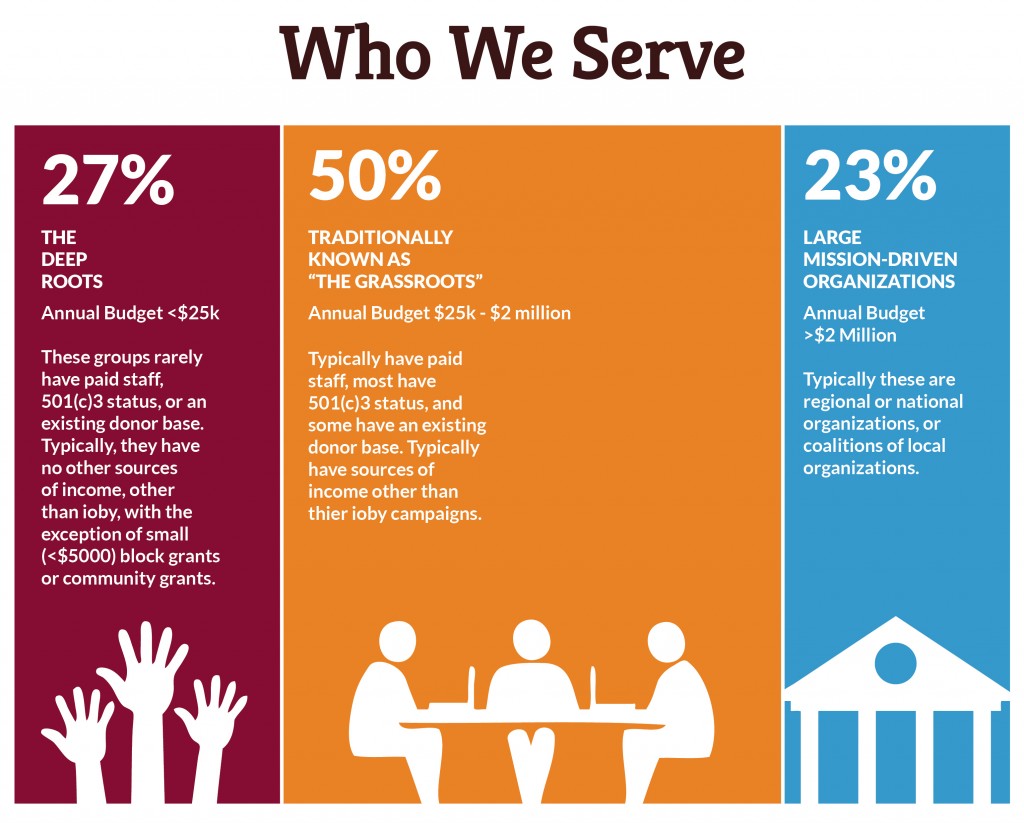Sure, crowdfunding works for small startups raising a seed money, or loosely affiliated groups of neighbors working together for the first time, but why would my large, relatively well-established organization want to crowdfund? After all, we have several established revenue streams, including foundation or corporate funding, an active list of engaged individual donors, maybe even a membership program. Where’s the added value in a crowdfunding campaign, especially if it means more work for my fundraising team?

[Nearly a quarter of our ioby Leaders represent larger, more established nonprofits]
We’d never argue that crowdfunding is the best fundraising tool at all times, but when used to complement other funding streams, it can actually help build a more sustainable organization in the long term. Here are some instances in which crowdfunding can be the right way for nonprofits to raise money:
1. You have a depressed donor base you want to invigorate
If your donor base could use new life breathed into it, a crowdfunding campaign can be very satisfying in addition to regular annual giving because:
- the asks are very concrete
- the funding goal is clearly communicated
- donors can understand their contribution towards the overall goal
- generally speaking, crowdfunded projects are typically implemented very quickly and those implementations, when communicated with the same speed, can be very satisfying to a donor.
In order to make this approach work, we’d recommend using both your email or mailing subscriber list and your current donors, and differentiating the ask very clearly from other asks, such as an end of year, annual appeal, and putting many months’ distance between those distinct campaigns so you have plenty of time to thank and follow up.
2. You want to audience-test a new program or approach
Crowdfunding can be an important way to say, “You are all familiar with our core work, which is critical to providing our basic mission-based services. We’re interested in trying this new approach and we’d like your support in experimenting with it—something institutional funders would hesitate to do.” If it’s applicable to your organization, ioby supports and encourages both permitted and non-permitted activities in public space to get the attention of government and to work for justice. It can be a powerful way for nonprofits to raise money for the kind of unpermitted activity that few institutional funders have the flexibility to support.
3. You need to quickly respond to a crisis
Many in our sector want to be able to serve our constituents quickly, compassionately, and effectively during a crisis, but restricted funding, long turnaround times for grants, and other challenges can make this difficult. Crowdfunding can be a way to build up additional unrestricted funds when your base is very activated. The motivation is clear, the ask is concrete, and the urgency is palpable. These are the most important components of a good crowdfunding campaign, and it also means it can be a powerful and effective way for nonprofits to raise money quickly. Because of the urgency, your most loyal supporters will be inclined to share the campaign with their networks.
4. You want to expand your base of younger donors
A crowdfunding campaign can be a useful way to use impassioned supporters to leverage their own networks. Similar to a peer-to-peer campaign, you can recruit your most passionate, energetic, youngest donors (even if they are giving at very small levels) and ask them to run a campaign to fund part of your work. In this way, you convert your donors into cheerleaders and solicitors on your behalf. Their personal ask to their friends is more compelling than an institutional ask, and your reach is expanded. This approach, of course, takes staff time to support.
Keep in mind:
- Real urgency is the most important part of a crowdfunding campaign. The fundraising appeal must be different from an annual appeal and distinct from language on your donate page.
- You want to keep integrity in your brand. When you use any crowdfunding platform, you’re directing your base to a third party site, and you want to keep the number of clicks to get to the donation as few as possible. It’s important to think through when you want to have complete brand control and when you don’t need it.
- Crowdfunding is a real campaign, and it takes work. These campaigns are best executed in collaboration with program work, and not by a development team in isolation — and that coordination takes work.
- Remember that crowdfunding is an important source of unrestricted funds. So strike the delicate balance of being specific while keeping the way you spend the funds as unrestricted as possible.
Are you with an established nonprofit and have an idea for a crowdfunding campaign to support your programs and complement your development portfolio? Share your idea with us, and we’ll reach out to provide key resources to help make your project a success!